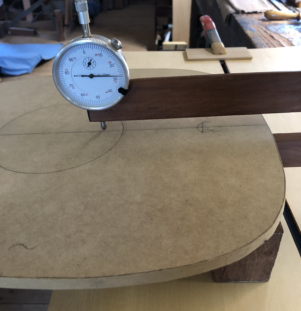Here is the Huon Pine soundboard. I will glue the two lengths edge to edge, cut the resulting board more or less to size – and then plane it down to about 1.6 mm.
Thereafter, a cabinet scraper comes into play: centuries of experience has established a formula for the thickness, which changes from edge to centre. The area reserved for the George Gerle rose will be about 1.2 mm thick.
You can see from the photo why my home-made gauge is made the way it is: I can use it to check and double-check each and every point on the soundboard. The various thicknesses are meant to enhance the quality of sound, or – we could say- the resonance.
Another finicky task – but worth doing properly….



I assume the soundboard acts like a drum. I wonder if the bottom of the lute also contributes to the resonance or only the top?
Greetings Richard. Yes, the soundboard is of much more significance than the lute body when it comes to acoustic qualities. Australian guitar makers use Huon Pine for soundboards; I will find out soon enough if it works for the lute – but I feel confident that it will.
Probably by the time you read this the nervewracking deed is done. How did it go? I still find it a very risky enterprise to carve the rose from the soundboard rather than a separate insert. But then you have patience and skills to do so.
Looking forward to hearing this lute soon!
Greetings Ian. Tim Guster the luthier recently gave me some excellent advice regarding the soundboard.
The next lute will be easier: it is just a matter of gaining experience/confidence – and improving my skills.